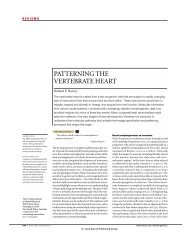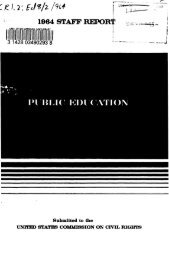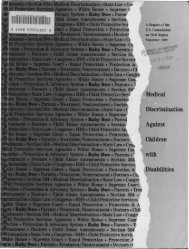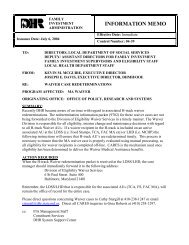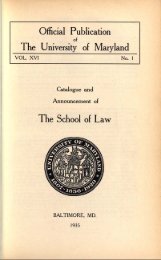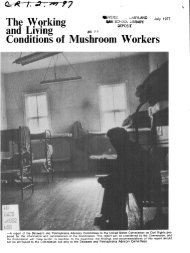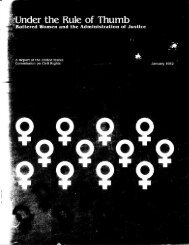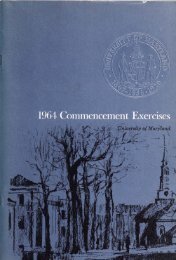1961 US Commission on Civil Rights Report Book 2 - University of ...
1961 US Commission on Civil Rights Report Book 2 - University of ...
1961 US Commission on Civil Rights Report Book 2 - University of ...
You also want an ePaper? Increase the reach of your titles
YUMPU automatically turns print PDFs into web optimized ePapers that Google loves.
for the two races. 8 After the clear statement in the sec<strong>on</strong>d Brown<br />
decisi<strong>on</strong>, quoted above, many other courts so held. 6<br />
Although c<strong>on</strong>stituti<strong>on</strong>al rights <strong>of</strong> this type have <strong>of</strong>ten been declared<br />
to be "pers<strong>on</strong>al and present," 7 the Court did not order immediate<br />
admissi<strong>on</strong> <strong>of</strong> the plaintiffs to the schools from which they had been<br />
barred. Since the acti<strong>on</strong>s were class suits, all pers<strong>on</strong>s in the positi<strong>on</strong> <strong>of</strong><br />
the plaintiffs in the defendant school districts were, <strong>of</strong> course, entitled<br />
to intervene and seek the same relief. The plaintiffs' c<strong>on</strong>stituti<strong>on</strong>al<br />
rights (if not their immediate legal remedy) were no greater than the<br />
rights <strong>of</strong> 3 milli<strong>on</strong> other Negro, and 7 milli<strong>on</strong> white, pupils attending<br />
compulsorily segregated public schools in almost 3,000 biracial school<br />
districts in 17 Southern States. 8<br />
The Supreme Court recognized the magnitude <strong>of</strong> the problem, saying:<br />
"Full implementati<strong>on</strong> <strong>of</strong> these c<strong>on</strong>stituti<strong>on</strong>al principles may require<br />
the soluti<strong>on</strong> <strong>of</strong> varied local school problems." e It placed "primary resp<strong>on</strong>sibility<br />
for elucidating, assessing, and solving these problems" <strong>on</strong><br />
local school authorities, and gave the Federal district courts the duty <strong>of</strong><br />
deciding "whether the acti<strong>on</strong> <strong>of</strong> the school authorities c<strong>on</strong>stitutes good<br />
faith implementati<strong>on</strong> <strong>of</strong> the governing c<strong>on</strong>stituti<strong>on</strong>al principles." 10<br />
The district courts were directed to observe "equitable principles"<br />
in rec<strong>on</strong>ciling public and private needs. The public interest was said<br />
to be the eliminati<strong>on</strong> in a systematic and effective manner <strong>of</strong> the obstacles<br />
to operati<strong>on</strong> in accordance with c<strong>on</strong>stituti<strong>on</strong>al principles. 11 The<br />
private and pers<strong>on</strong>al interest <strong>of</strong> the plaintiffs was declared to be the<br />
realizati<strong>on</strong> <strong>of</strong> their c<strong>on</strong>stituti<strong>on</strong>al right <strong>of</strong> admissi<strong>on</strong> to public schools<br />
<strong>on</strong> a n<strong>on</strong>discriminatory basis as so<strong>on</strong> as practicable. 12<br />
Although not expressly stated, the rati<strong>on</strong>ale <strong>of</strong> the Supreme Court's<br />
decisi<strong>on</strong> to permit a delay in the enforcement <strong>of</strong> the plaintiffs' rights<br />
appears to be that the public interest in an orderly administrati<strong>on</strong> <strong>of</strong><br />
public schools in <strong>on</strong>e-third <strong>of</strong> the Nati<strong>on</strong> could, for a limited period,<br />
outweigh their pers<strong>on</strong>al interest—at least in the factual situati<strong>on</strong><br />
presented.<br />
Hence the Court provided for a period <strong>of</strong> transiti<strong>on</strong> from a segregated<br />
to a n<strong>on</strong>discriminatory school system and, after adm<strong>on</strong>ishing the<br />
lower courts to require "a prompt and reas<strong>on</strong>able start toward full<br />
compliance with our May 17, 1954, ruling," 1S enumerated the factors<br />
that may be c<strong>on</strong>sidered in determining what additi<strong>on</strong>al time, if any,<br />
might be "necessary to carry out the ruling in an effective manner." 14<br />
The burden <strong>of</strong> pro<strong>of</strong> that additi<strong>on</strong>al time was required was placed up<strong>on</strong><br />
the school authorities.<br />
Problems <strong>of</strong> adjustment<br />
The factors that the lower courts were authorized to c<strong>on</strong>sider in granting<br />
additi<strong>on</strong>al time for good faith compliance at the earliest practicable<br />
date were: "<br />
6




